EXPLORING THE CÔTE D’AZUR HINTERLAND

The Côte d’Azur has so many wonderful attractions, many of which aren’t associated with beaches, famous luxury hotels or shopping—although the area offers plenty of all those! If you’d like a little time out from the activities of the cities, beaches and what we think of as the typical Riviera pursuits, think about heading up into the surrounding hills and little villages perched on the slopes that dot the landscape, so near and yet so far. We try and make time to explore a couple of these whenever we’re in the area, and have loved discovering such gems as Tourrettes-sur-Loup and La Turbie. There are also a couple of absolutely delightful train trips, such as the Train des Pignes, up into the beautiful mountain areas that can really enhance a Riviera holiday.
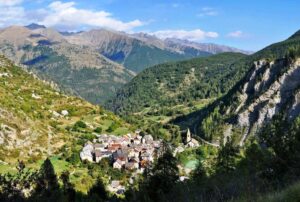
It’s fairly certain that the majority of Riviera visitors are there for the beaches, great places to eat, shopping for resort-style fashion—the alluring Mediterranean attractions. To round out a stay in this region, a day trip or two up into the hinterland is to discover some of the most beautiful terrain, small towns and villages in the entire country. We’ve already had a look at St Paul de Vence and Vence in the last story, but a number of other destinations are within easy reach of Nice, in particular.
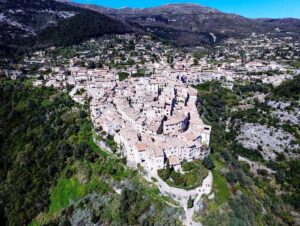
At only 14 kms from the coast, between Nice and Cannes, 8 kms from St Paul de Vence and just 5 kms from Vence, lies Tourrettes-sur-Loup, a charming medieval village which is well worth a detour. Perched on a rocky outcrop surrounded by a beautiful landscape, the village seems to conquer all beneath it with its tall houses built along its ramparts.
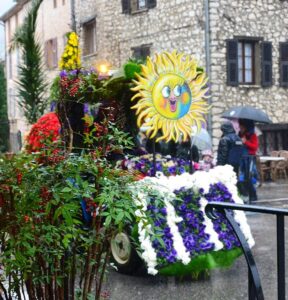
The best way to discover Tourrettes-sur-Loup is by wandering around its attractive, narrow streets, its vaulted passageways, admiring the well-restored stone façades and slowly climbing up some of the stepped passages, bordered with colourful flower baskets. The village isn’t called “the violet village” for nothing, since for over a century, this pretty little flower has been grown in the village. It’s honoured each March with a flower festival, decorated floats and a battle of the flowers.
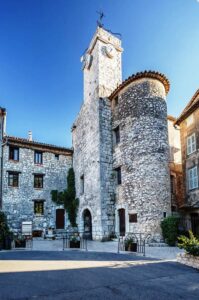
The heart of the historic centre of the village is the Grand Rue that follows the circumference of the village, where you’ll see about 30 artists’ workshops, galleries and crafts workshops making jewellery, pottery, paintings, fabrics and more. In a small square is a must-see, the Hotel de Ville, that was originally the small Château des Villeneuve, dating from the 15th century. A delightful outdoor market takes place every Wednesday morning at Place de la Libération, where you can stock up on a variety of goodies and local produce. Also have a look at a lovely 16th century church, Saint Gregoire.

Getting to Tourrettes-sur-Loup from Nice by public transport isn’t difficult. Take bus no. 09 from Nice’s Grand Arenas bus stop to Vence, which takes around 46 mins., then transfer onto bus no. 651 to Tourrettes-sur-Loup. Or you can take a train from Nice Ville, the main railway station, to Cagnes-sur-Mer, which takes around 15 mins., then from there, more or less across the road is the bus stop, Square du 08 Mai. Catch a bus no. 09 to Vence, which will take around 18 mins., then bus no. 651 across to Tourrettes-sur-Loup, which is less than 15 mins. away. Sounds messy, but actually very do-able. Of course, easiest and most direct of all is to drive, which takes around 30 mins. The road goes through Cagnes-sur-Mer, then via St Paul de Vence and Vence.
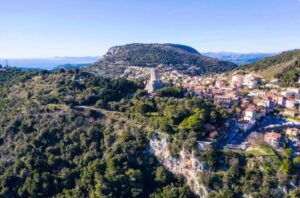
Another lovely day out is to head to La Turbie, slightly north of Monaco, on the spectacular Grand Corniche road that runs from Nice to Monaco—one of the great scenic highlights of this region.
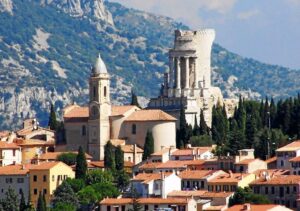
The town is especially famous for the large Roman monument, La Trophée d’Auguste (Trophy of Augustus), erected around 6 BCE to celebrate the Emperor’s victory over the Ligurian tribes of the area.
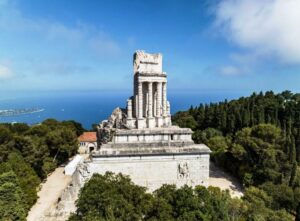
The monument once featured an enormous statue of Augustus on top. The views from the monument are breathtaking—among the best on the Riviera. Apart from La Trophée, one of the biggest drawcards of La Tubie is the scenic viewpoint of Tete du Chien (literally: Dog’s Head) that overlooks Monaco. This spot is an easy 20-25 min. slightly uphill walk that takes you out to the edge of the cliffs overlooking the coastline below.
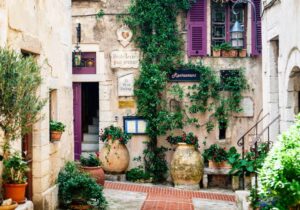
During the Middle Ages the village was mainly under the dominion of the Republic of Genoa. Dante wrote in his ‘Divina Commedia’ that Turbia was the western limit of the Italian Liguria. It was also alternatively part of Savoy and the Principality of Monaco, from where the local population assimilated the Monegasque dialect mixed with a local version of the Ligurian dialect. La Turbie is very small, and has largely kept its charm and authenticity, with its harmonious mix of classic, medieval and baroque architecture. Much of the village’s earliest buildings were built using stones from the Roman monument. There are 4 Portails, or medieval gates, to the village located around the perimeter of the historic village. You can see the ramparts from the Middle Ages, stroll along the cobblestone streets and through arched passageways, pass by a Romanesque fountain and a beautiful Baroque church with its square belltower. There are plenty of restaurants and cafes in which to relax. There are also a couple of hotels, one of which we understand has a Michelin-starred restaurant.

La Turbie is also the cradle of mountain car races. This started on 31 January 1897, when the last stage of the Marseilles-Nice race was a 17 km. hill climb between Nice and La Turbie. This race was won by Andre Michelin, behind the wheel of a De Dion steam-powered engine, that reached an astonishing speed of 31.8 km p/hr! Another, more unfortunate event occurred on 13 September 1982 when Princess Grace of Monaco was killed in a car accident at Cap d’Ail, near La Turbie on the Route de la Turbie road.
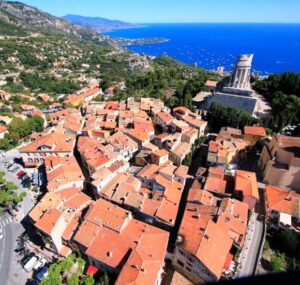
Getting to La Turbie from Nice is straightforward. Take a train from Nice Ville station to Gare de Monaco-Monte Carlo and then bus no. 603 from the railway station up to La Turbie, which will take around 25 mins.
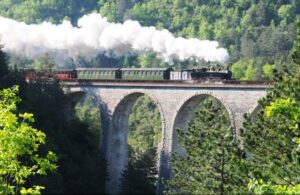
For something completely different for a great day out of Nice, the Train des Pignes is a scenic train ride from the coast up into the mountains.

The train uses Gare de Nice at 4, Rue Alfred Binet, about 6 blocks from the main railway station. It runs on the Chemins de Fer de Provence railway line, which is a separate rail service from the SNCF and does not use the same stations. This connects Nice on the Riviera with the historic town of Digne Les-Bains, in the heart of Haute Provence, taking you from the sea to (potentially) snow-capped mountains in just 3 hrs 30 mins. The Train des Pignes passes through two regions: the Alpes-Maritime Alps and the Alpes de Haut de-Provence. Along the way, you peer down into deep gorges, and pass gentle olive groves, fields of Provençal herbs and medieval fortresses.

The idea for the Train des Pignes was proposed in 1861, but due to the many construction challenges of the terrain, it was not until 1911 that the line finally reached Nice. The route covers a distance 150 kms, with 25 tunnels, 16 viaducts and 15 metal bridges. The new trains on the route have large windows that allow travellers to fully enjoy the passing landscape: uninterrupted vistas of waterways, mountains, gorges and valleys, some of which are not accessible by car. The ride is a great, scenic adventure! However, there is also the option of taking the recently restored historic steam train. Check with the Nice Tourist Office for specific details. The name ‘Train des Pignes’ comes from the pine-cones that were once used as tinder to start the steam engines of the original trains.
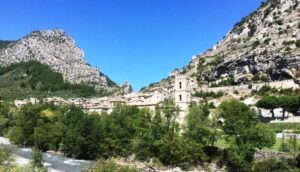
The journey begins through the city streets of Nice, then passes through a few tunnels to the little stations of La Madeleine and St Isidore before dropping down to the Var valley and Lingostiere station. Along the Var river the train stops at various stations along the way to Plan-du-Var. From there, at the mouth of the rugged Gorges de Vésubie, then the gorges of the Var river. Stops along this section include the villages of Villars-sur-Var, the tiny 12th century village of Touet-sur-Var, and Puget-Theniers, where the steam trains are garaged.
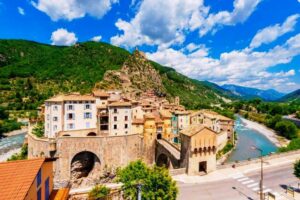
After Puget-Theniers, it’s only a few minutes to the station at the fortified village of Entrevaux and its high Vauban fortress, which guards a narrow gap in the mountains. Then the train continues along the deep river valleys through hills and west towards Annot, which is at the other end of the steam-train section. A few minutes after Annot, at the little village of Le Fugeret, in the beautiful Vaire river valley, the train climbs up through a tunnel and loops around on itself in order to gain enough altitude to continue north.
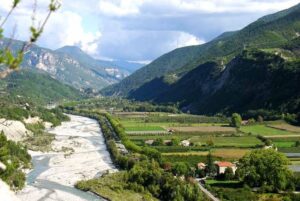
There’s a stop at the mountain side below the little perched village of Méailles—you need to inform the conductor when you get on if you wish to alight here—down into river valleys alongside rivers, through the mountain park area of the Trois Asses. Huge birds of prey such as buzzards and harriers, are a common sight up here. Then there’s the final stretch into Digne-les-Bains. Bear in mind that the train ticket allows passengers to take a later train back to Nice, or even stay overnight at Digne, perhaps take one of the hiking trails, or simply relax and explore the town.
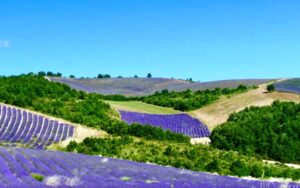
Dignes is an important centre for growing lavender for the perfume industry and especially lavender essential oil. If you want to see hectares and hectares of the plant, and with the air heavy with its perfume, plan on visiting between 15 June and the end of July. The flowering lasts until the end of August, but lavender is harvested from the second half of July.
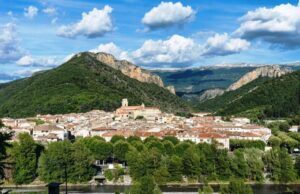
However, long after the harvest, the air is still fragrant with the scent from the cut plants. Since 1939, every year on the first weekend of August in Digne, the town celebrates its best-known crop with parades of decorated floats, locals dressed in traditional Provençal costume, musical groups, a fun fair and evening fireworks. The town has a Lavender Museum that tells the story of the cultivation and uses for its famous plant.
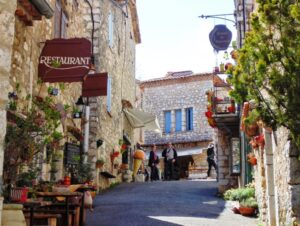
There are so many more wonderful things and sights to explore in this part of France, that I haven’t even touched on, such as Gourdon, Saorge, Saint Agnes, or Peillon, just to name a few more spectacular villages in the Alpes-Maritimes—enough to fill many happy days. Instead of spending all your time in the cities and coastal resorts, add an extra day or two to discover some of these other delights as well.
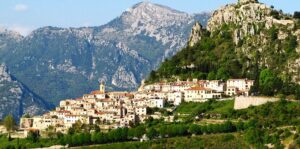

Lois Lovedee
Sounds wonderful. And thanks for the public transport directions . I’m hoping to go next September. Never again in August – too hot and too crowded .
Cheryl Brooks
Hi Lois,
Delighted you enjoyed the story, and I hope you’ll find the transport info. useful as well. One of the guidelines to the subjects I choose to write about, is that the destination/s are accessible by public transport, as I know very well that not everyone will be in a car. The good thing about France is that their public transport system, no matter where you are in the country, is really outstanding, and it’s getting even better, with expanding networks, to discourage people flying as much as possible. For example, I read this week that as of this week, new, superfast trains are going direct from Paris to Vienna as an overnight train, and also a daytime train from Paris to Berlin, which will take around 8 hrs. Actually very doable, when you think of the time wasting at airports. I also think you’re wise to avoid Europe in August in future. I’d never go at that time, as it’s far too hot and you simply can’t get around comfortably. Yet Sept. is often the nicest month, with cooler mornings and evenings, but warm days–although having said that, this year was the wettest Sept. in Paris in many years! However, it would’ve been better than boiling in August! If you’d like to ask me for any other suggestions for your trip next year, don’t hesitate. Cheers for now, Cheryl
Nadine Connor
As always, so comprehensive and informative
Well done.
Cheryl Brooks
Many thanks for such high praise Nadine! I enjoyed doing this one in particular, as it’s an area we know well and enjoy returning to, and I like encouraging others to discover it too. Thanks again, Cheryl
Anna Candler
Wonderful way to travel when you are in Sydney, listening to the thunder and rain.
Cheryl Brooks
Yes, even better to be indoors looking out, than struggling home in it! However, we’ve experienced some spectacular storms in Provence over the years, that makes Sydney’s efforts seem quite tame! Cheers, Cheryl